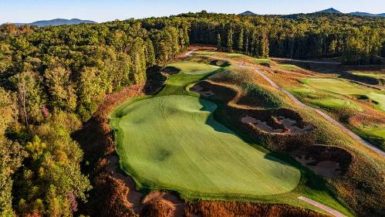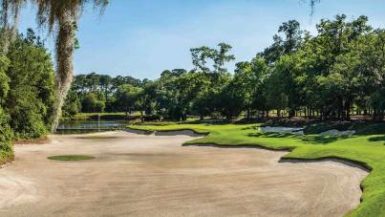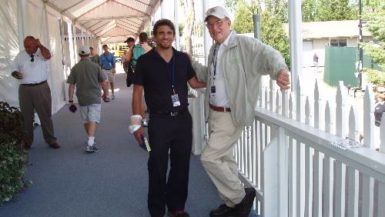PINEHURST, NC – GOLFTOWN, USA
While covering the 2005 U.S. Open for my first writing gig, I kept an open mind all week as the world debate raged on whether $375 is too much for a round of golf at Pinehurst No. 2, or whether $240 is too much for Nos. 4, 7, and 8. I listened to the good points raised on either side – and there are plenty to go around. Even I struggled with the analysis. It’s a tough and close debate.
The natural setting is not Pebble. Or Bandon Dunes. Or Whistling Straits. Or even Kiawah Island. But that’s OK. Look at Sawgrass or Bethpage. They don’t tip the scales for natural setting, but are two of the most quintessential tracks in the nation.
It’s not solely the course design either. A.W. Tillinghast wrote of his classic Winged Foot, “The holes are like men, all rather similar from foot to neck, but with the greens showing the same varying characters as human faces.” The same is true of Pinehurst. Certainly Pinehurst’s greatest weapon is its benign nature tee to green as well as its intricate green complexes. The wide fairways, devoid of stunning vistas lull the player to sleep when he should be on high alert. The design from tee to green is so non-descript that the nuances escape most golfers, until they find themselves in a greenside swale. One mistake approaching the devilish greens and the ball is in a place where the player cannot get close to the hole to save par. No less a personage than preeminent architect Tom Doak called No. 2’s green complexes “the best in America.”
But over time, the greens morphed into something different from what Ross intended. Ron Whitten wrote an insightful piece, “Donald Ross Wouldn‘t Recognize These Greens” in the June 2005 issue of Golf Digest. His undressing the myth of the greens’ severe contours as a mountain of topdressing compiled over decades, not Ross’ design, fills in a vital piece of history. Moreover, the USGA took advantage of the increased height of the greens by cutting off sharp slopes so as to create false fronts and sheer side drop-offs to make for crazy bounces at severe and unpredictable angles.
With two such analytic geniuses jousting, the debate is surely valid on both sides. Either way, Pinehurst is not overwhelming, overly penal or heroic. Instead, No. 2 is a tricky pickpocket, an Artful Dodger which steals strokes right from under your nose…except when the USGA comes to town for the Open – then it becomes an axe murderer and a serial one at that. Still, there are seven other courses as of this writing.
It’s not the price either. $375 is half a month’s rent, a luxury car payment, two dinners for two at the glitziest NYC restaurant, tickets for four to a Broadway show, or tickets for a family of six to a major league baseball game (or tix for two to a three game series). Only Pebble Beach, Cascata and Shadow Creek are more expensive in the U.S. Sawgrass is half the price and Bethpage is 1/4 or less.
It’s not Donald Ross either. Yes, Ross is a seminal designer, and yes, he was able to fine-tune the strategic genius of Number 2 all his life, but I don’t “drink the Donald Ross Kool-aid” and genuflect on command. (I know the Donald Ross Society will want to grill me alive for saying that. But hey, as St. Lawrence quipped, “Turn me over, I’m done on that side.”.) I study golf course architecture as a science not a religion. Yes, Pinehurst No. 2 is brilliant, but some say it may not even be Ross’ best work. Many choose Inverness or Seminole as his best.
But there is a reason why Pinehurst is the St. Andrew’s of America, Golftown, USA if you will – and I am not handing out that mantle lightly and it’s not just because of the unique and wonderful golf course. It’s the people. It’s the Pinehurst locals and the North Carolinians. Pinehurst is EXACTLY like Ireland or St. Andrew’s in one critical way. The magic of Pinehurst is in meeting the locals. The apres golf is unparalleled. Maybe only Oregonians can match North Carolinians for warmth and hospitality. It even tops Pebble Beach – where you stay at the resort, but don’t interact with the natives. Instead, here even your waitress or counter clerk will discuss golf history or swing mechanics or travel with you. Golf is embedded in every level of the local’s lives. In Pinehurst, the locals have golf in their DNA. The town is the heartbeat of American golf. After five generations, the game is in their DNA. You lose out on so much if you just play golf and leave – or play golf and go crash in your resort suite. Instead, if you delve deeply into Pinehurst’s greatest treasures, its people, you will be rewarded in return tenfold. Come to play golf, but leave with ten friends. It’s as though you can buy shares of stock in the town’s soul.
If you love Pinehurst, Pinehurst will love you back. Many who do this, soon have a bumper sticker on their car that reads “PINEHURST – I wasn’t born here, but I moved here as fast as I could.”
ON THE COURSE
In their book, The Golf Course, architect Geoffrey Cornish and writer Ron Whitten praise the deceptive design. The holes are straightforward appearing from tee to green, but with pronounced swales and devilish chipping areas counterbalancing deep eyebrow bunkers, approaches must be pinpoint accurate.
Tour player Thomas Levet opined that “many of them are really two tiny greens instead of one large one. Take for example number 9, there’s a little area top left and there’s a little area bottom right and that’s it.” Additionally, players rarely find a good or consistent lie in the rough. Fairways are canted with the slopes feeding the ball in unexpected directions. The greenside swales, mounds and hollows pose more difficult recovery problems than the sand.
Levet dissected the secret of the greens in that one sentence. Now if the greens play that small from optimum angles, imagine how tough a target they present from the rough or from angles that if you miss, the ball is in jail. The course is fiendishly clever in its intricacy, despite its sedate appearance. Pinehurst is a chess match on grass.
Payne Stewart won his chess match in 1999 with solid planning and strategy. He walked the course with Chuck Cook, who pointed out in Payne’s yardage book areas around the greens from which it was highly improbable to get up and down. Payne asked Cook to mark those areas in red. Cook responded “I’ll mark them in blue because I don’t want you to be afraid of them.” These are now referred to in jargon as the “blue areas.” Instead, he marked the middle of the fat areas of each green with an “X” and had Payne “hit for the X” all week.
Cook wrote, “A good example of how this worked was on the eighth hole, where left or long is no good. Consequently, his target was the front-right of the green. Payne aimed there every day and played the hole one-under for the week. You might recall the eighth as the hole where John Daly played hockey up the hill, finishing with an 11.”
Payne hit it in the blue areas once in 72 holes, on number 2 on Sunday and he was lucky to escape with only a bogey. That’s how he won.
That’s also how Retief Goosen lost the 2005 U.S Open. “If you are on the wrong side of the flag, it always feels like you can putt it off the green on the other side or chip it over the other side. It was very difficult to commit to hit it hard enough at places and that’s where every time I chipped up the hill I chipped it short or when I putted up the hill I putted short so I couldn’t get the pace right today.” Goosen, Jason Gore and Brandt Jobe, all playing in the last or second-to-last group were +35 collectively and uniformly testified to the ferocity of the angles out of the rough, (although one irreverent wag opined to me that maybe it was the fault of the mushrooms served at noontime in the clubhouse).
The chipping areas are so severe, Lee Westwood added, “You have to be very defensive out there. It’s very difficult. If you miss the green, sometimes you have to treat the hole as a dogleg and play four or five feet away from the hole and hope to make the putt.”
Many people mistakenly describe the greenside swales and mounding as “subtle,” but that’s way off. Being three to six feet below the pin and facing drop-offs on all sides and behind? That’s about as subtle as a Louisville Slugger.
Of all Ross’ masterpieces, Pinehurst is the most complete and unique because he tinkered with the course for thirty years – just as his mentor Old Tom Morris tinkered with the Old Course and Glen Dornoch most of his life. Doak noted, “Ross himself said his treacherous greens and links-style greenside swales brought into play an infinite variety of recover shots that other hazards cannot induce.” The pronounced slopes and valleys are an ever changing and limitless challenge to players to creatively invent shots and then execute them with feathery touch. The greens slope in all different directions – front to back, side to side and even diagonally.
Sure the fairways are wide and seemingly straightforward, but his crowned greens and eyebrow bunkers strategically and randomly placed where the land naturally accepted them are often imitated, but not yet equalled. Doak notes “The slightly-raised, intricately contoured greens and the fairway-height bumps and hollows which surround them are identified by many amateur architecture buffs as the epitome of Ross style, but in fact they are unlike almost all other Ross courses I’ve seen.” (From The Confidential Guide to Golf Courses.)
Doak continues by noting that “it is the hollows and green settings, rather than the greens alone” which define the green complexes, giving them an extra strategic dimension and making a wide variety choices available to players for recovery shots.” The hollows closely resemble the undulations of his native Scotland, especially St. Andrews. Ross lived on the site and tinkered with the design all his life.
I thought Andy North and the boys at ESPN were clowning around when they bounced golf balls off of upside down mixing bowls, but they were spot on. The only amendment is rather than a true circle with the target on the center, the tops of the bowl are smaller and spread around the unique contours from green to green. It’s all about the angles. To set up the angles to the green, you have to be in the right place off the tee. The happenstance of the topdressing may actually have improved Ross’ design to make it even more fearsome.





$375 is half a month’s rent? Are you sure you live in NYC?
Every played Aronimink? Ross called that his “masterpiece” over #2 or any other…